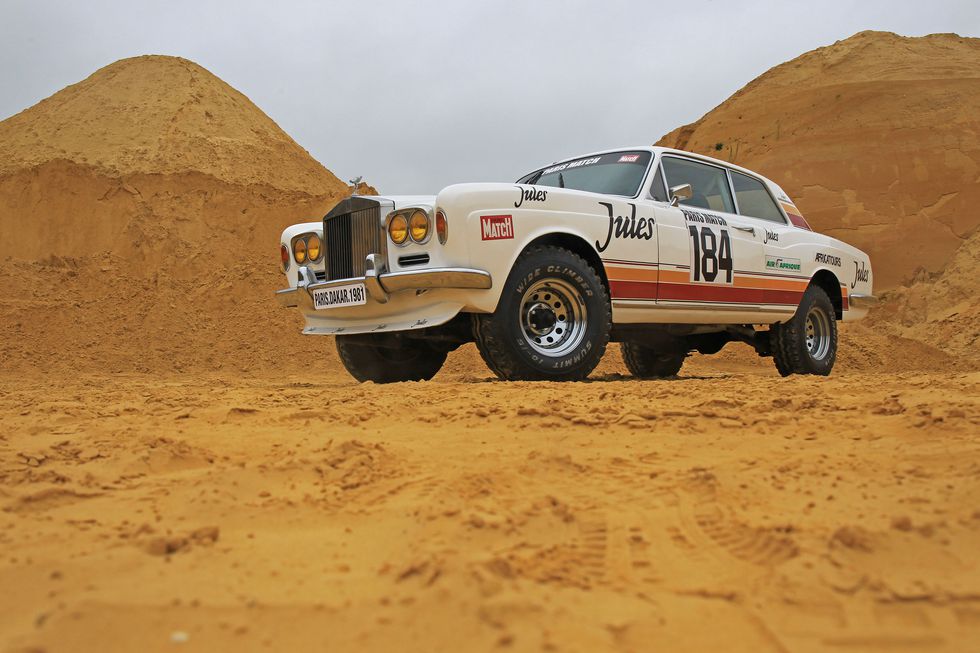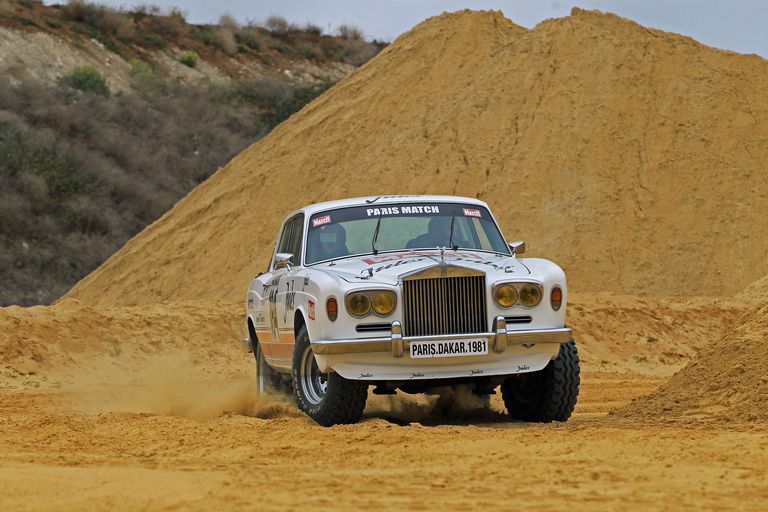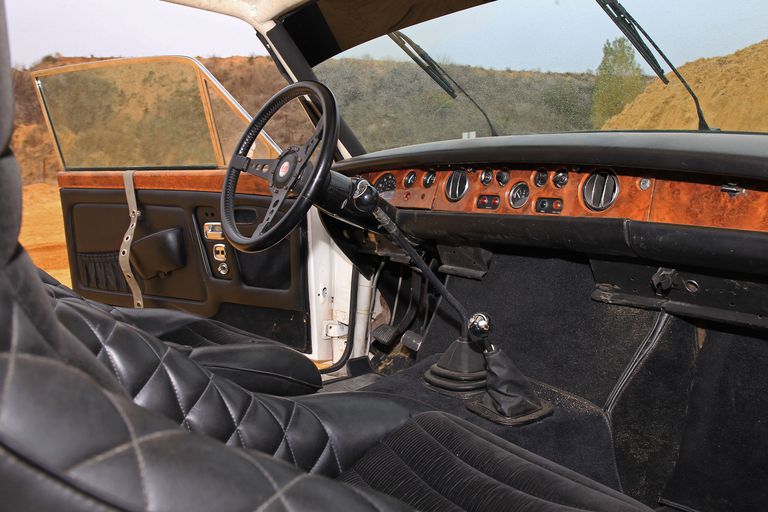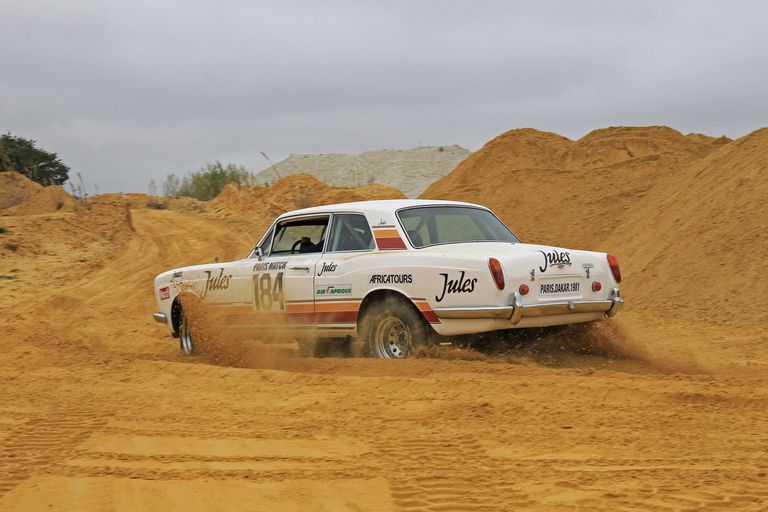Those demanding the car could be forgiven. That very cool and very un-Rolls Corniche actually existed, but the company had nothing to do with it. It was the star of that year’s Paris-Dakar Rally, the hellishly long and arduous race across the Sahara from the post-Christmas revelry of Paris to the winter warmth of Senegal in West Africa. The event's beginnings saw amateurs having a bash in the family 2CV or farm Land Rover. But, by 1981, it had started attracting factory Range Rover teams and race legends like F1 and Le Mans winner Jacky Ickx.
Not surprisingly, Thierry de Montcorgé and Jean-Christophe Pelletier were not taken too seriously when their Rolls lined up with 290 others in the French capital. But at the race's halfway mark they were 13th. The rivals's view of the car had changed completely.
The super suave De Montcorgé, who would not be out of place if thrown in a gaggle of other unconventional and swashbuckling Rolls drivers like Lawrence of Arabia, invited me to a sandpit just outside Paris to drive the Corniche.
“It was Jean-Christophe's car. And because it was often [breaking down], we decided to put it in the desert,” Thierry recalls. The ‘eureka’ moment came aided by copious amounts of Pomerol over a lunch in Bordeaux. On the outside it still looks like a Corniche, albeit one that has had an intense course of steroids. But that is where the similarities end.
“The oysters only lasted for three days,” smirks de Montcorgé.
The rally Rolls is designed to be strong and comfortable, but to also have huge grunt. With up to 500 miles a day to endure, little else mattered. One stage, en route to the mythical oasis of Timbuktu, stands out in Thierry’s mind as where the Rolls was at its best. “It was a big desert in the south of Algeria. In my memory the sand was very white and so smooth. The car was running perfectly. I keep this image in my head.”
It's a trip down memory lane for me too. I've commentated on 14 Dakars since 1987–when Peugeot brought their outlawed Group B rally cars and superstar drivers like Ari Vatanen to the desert–and I've been to the remote corners of the Sahara where the Corniche excelled. Nor am I a stranger to driving a Rolls off-road. A few years ago, I led a 6000-mile trip round South America in a Phantom, including some gnarly dirt and sand sections in the Atacama Desert. Without all the rally paraphernalia, the Phantom soaked up the conditions amazingly well.
Like an English stately home which has been stripped of its lavish furnishings, the Corniche no longer smells of Connolly leather and Chanel No.5. The odor is now of stale fuel and eau de old car.
“The car is almost exactly as it was when it finished the Dakar,” Thierry says as I get comfortable in the drivers bucket seat. “We knocked out a dent in the front, that’s all.”
“Forget the brakes,” Thierry advises before I double-declutch into first gear. “They are almost non-existent.”
The course we have is a 1/3 mile loop up and over a pile of sand so yellow, Dorothy, the Tin Man and even Elton John would feel at home. It was also soft. I walked it and sunk up to my shins in places. But Thierry tells stories of climbing 100 foot African dunes in this monster so I short shift into second and let the immense torque and squidgy sand tires paddle away beneath.
It might have four wheel drive now, but somehow this desert brute has retained some of the Spirit of Ecstasy. The Corniche’s steering is still finger-tip light, the ride is supple and (as Rolls like to say when questioned ) it has ‘sufficient’ power. 350hp back in 1981, though I suspect it's less now.
Driving a boat or riding a Jet Ski is a good skillset to have when driving in sand. If you aren't using the power, you aren't turning. And once I plow through and over the deepest sections with no hint of bogging down, I play with the power band to make this brute dart this way and that.
The more I tickle the throttle, the more playful the Dakar Corniche becomes. The original suspension groans a little and the lack of speed in this sandpit makes it run a little hot but the years have not sapped youthfulness.
Three weeks of driving this car for 12 to 14 hours a day on sand and rock is unimaginable. I pull up, get out and now see Thierry as a hard-core adventurer, not as a debonair playboy. His car isn't a joke of Tonka truck, but a sublime yet simple piece of engineering that just happens to have a Rolls-Royce grille.
If the team wasn't disqualified for an illegal repair after a collision with a tree in Burkina Faso in 1981, the Rolls could have finished high on the Dakar leaderboard. It was still allowed to arrive in Dakar unclassified. Possibly because Jules had laid on enough champagne (and maybe oysters) in Dakar for the whole event.




 RSS Feed
RSS Feed